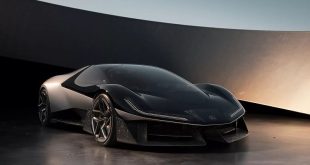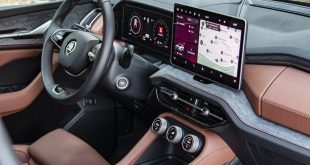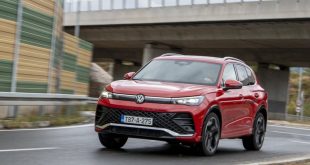At a time when there is insistence on partial electrification, which they say is a prelude to the announced electrification with which new “clean” cars will be driven only by electric motors, Renault, along with the redesigned edition of its long-confirmed bestseller, offers a version whose turbo gasoline engine is powered by two tanks.
An excellent concept, because with 39 liters of gasoline and 32 liters of LPG (LPG), the French “hybrid before hybrids” can cover more than 1,400 kilometers on the open road… with minimal emissions of harmful gases.
The world has already seen the first photos of Renault’s new models that hide behind the well-known numbers 4 and 5 and will soon be available in editions that (if nothing changes in the meantime) will be powered only by electric motors. The aforementioned world definitely likes what they imagined, drew and made in Boulogne-Billancourt. We like it too, because the shape also evokes memories of some more romantic times, but we won’t lie: we are in the company of those who think it’s a shame that Renault’s new creations on the theme of the legendary “fours” and “fives” are not even planned hybrid drive solutions that bring with them electric motor(s) and some kind of internal combustion engine.
Why not an emphatically clean and economical “old school” hybrid combination that, instead of a complex assembly of electric motors and engines (powered by electricity and gasoline), consists only of a simple and economical small engine with a turbocharger powered by gasoline and half-cheap autogas? A long-proven solution with which Renault remained in the small company of car companies that, in addition to the already adopted partial and full electrification, also have the excellent mentioned solution for the popular duo Clio/Captur, with which the final abandonment of diesel engines should be quite painless.
The fifth Clio, which in the meantime reached a tastefully redesigned edition, can still be obtained in combination with the well-known and proven four-cylinder 1.5-liter turbodiesel engine (101 hp) that consumes “drop by drop”, but almost 2,000 kilometers traveled revealed to us that Renault’s “golden bar” from the B segment can be extremely economical/environmentally friendly even in a “bi-fuel” combination with a small-liter three-cylinder turbo engine that runs on gasoline and autogas, and the fact that the equally equipped “hybrid” Clio is significantly cheaper than version powered by the aforementioned turbodiesel engine.

Photo: EZ/Klix.ba
Renault says that the smooth three-cylinder turbo petrol engine, when the fuel switch is switched to petrol, develops 91 HP and 160 Nm. With the autogas drive, an additional ten “horses” and ten Nm of torque arrive, which contributes to slightly better (intermediate) acceleration and top speed, but that is much less important in this story than the information that with 39 liters of gasoline and 32 liters of autogas, it will be semi-loaded Clio on the open road (at speeds of up to 90 km/h) can cover more than 1,400 kilometers.
With a defensive approach (with activated Eco work program, start/stop system and changing gear according to the order of the “shift” light) there is no waste of fuel even in congested city conditions, and the time on the highway (at a speed of up to 130+ km/h) showed is that two tanks should be enough to travel about 900 kilometers. And then we thought about the prices of comparable electric cars, the time wasted on generally slow battery chargers and the favorable price of autogas, and with simple math and logic we came to the conclusion that the not so clean and harmless “electricians” are in a rather unfavorable situation in this case. situation.

Photo: EZ/Klix.ba
The refreshed Clio, whose otherwise beautiful “face” on an extremely harmonious body with new housings for the main and daytime LED lights, now looks even better, is absolutely ready to continue the very successful story of its predecessors of the same name, which, since the first generation, have allowed Renault employees to draw and make failed models, without of fear that finances could irretrievably go “into the red”. In Renault, they say that with the new solutions, they have provided more places for passengers and luggage compared to what was offered by the previous generation, but considering the category to which the Clio belongs, we should not forget that adult passengers in the back seats will also have legroom here. enough centimeters only if people of shorter stature are sitting on the comfortable front seats.
Given that the autogas tank is located in the space where the spare wheel would normally be, the “bi-fuel” Clio brings an unreduced volume trunk behind the backrests of the rear seats, which in most cases should be enough for a younger/older couple or a small family. If you need more, there are larger or smaller roof boxes, because the fact is that B segment cars are often used not only in urban and suburban conditions.

Photo: EZ/Klix.ba
With the rationally measured Evolution equipment package, there are no aluminum rims, automatic air conditioning, the best upholstery materials and the most luxurious multimedia system behind the largest screen, which can be obtained with more expensive packages in an emphasized ergonomic and well-insulated cabin, but also a more modestly equipped Clio essentially with you it brings everything it needs, which confirms that it can be effortlessly traveled much further than what is usual for cars of this category.
We didn’t mind the lack of a large “television” in the central part of the console, because we were much more pleased with the level of finishing that excluded all unnecessary sounds. The bad news for ladies and gentlemen who don’t want to use their left foot is that they’ll have to look for one of the other powertrain options for the Clio, as Renault’s petrol-gas story can only be had in combination with a manual 6-speed gearbox.
Blessed with a well-tuned and quiet suspension, a fairly precise steering system and efficient brakes, the lightweight Clio demonstrated that it absolutely despises understeer, which is very often an integral part of front-wheel drive cars in a dynamic rhythm through turns, and the 16-inch rims on which are not too shallow tires, which is best felt on uneven surfaces such as worn city streets with often too deeply pressed manhole covers that are often placed exactly where they should not be.

Photo: EZ/Klix.ba
Buyers who put performance above all else, and the redesigned Clio is the most attractive among the less and less unlifted cars of the B segment, could be satisfied with the hybrid version (143 HP) powered by a four-cylinder 1.6-liter engine supported by an electric motor, which is now the most “horses” ” along with the model whose most powerful versions until the presentation of the fifth generation stood behind the famous Renault Sport department. At the same time, buyers who were thinking about the diesel variant primarily because of the fuel costs should put everything on paper and think again, because the fuel-efficient and environmentally friendly Clio (with a price that is quite fair these days) that runs on gasoline and autogas in that imposes on the case as a serious (better) alternative.
- Basic information about the test car: Renault Clio TCe 100 LPG Evolution
- Price of the test model without options: 35,500 KM
- Engine: Three cylinders, 4-stroke, located forward transversely. Working volume 999 cc, turbocharger, four valves per cylinder. Maximum power (gasoline) 67 kW – 91 HP from 4,800 to 5,000 rpm. Maximum torque 160 Nm from 2,100 to 3,750 rpm. Maximum power (LPG) 74 kW – 101 hp from 4,600 to 5,000 rpm. Maximum torque 170 Nm from 2,000 to 3,500 rpm.
- Power transmission: Front axle drive, 6-speed manual gearbox, tires size 195/55 R 16 87H (Continental EcoContact6).
- Performance and fuel consumption: Acceleration from 0 to 100 km/h (petrol/LPG) – 12.5/11.8 s. Top speed (petrol/LPG) – 180/188 km/h. Fuel consumption on test (gasoline): from 4.3 to 6.3 l/100 km. Fuel consumption on test (LPG): from 4.9 to 8.8 l/100 km. Average consumption according to WLTP norms (petrol): from 5.3 to 6 l/100 km. Average consumption according to WLTP norms (LPG): from 6.7 to 7.8 l/100 km. Average CO² emission: 121-136 g/km (LPG 107-121 g/km).
- Dimensions: Length – 4,053 mm, width – 1,798 mm, height – 1,439 mm. Wheelbase – 2,583 mm. Trunk volume from 391 to 1,069 liters. Weight of the empty car – 1,144 kg. Maximum permitted weight – 1,641 kg. Fuel tank volume (gasoline/LPG) – 39/32 lit.
- Standard equipment of the test car: Renault Clio TCe 100 LPG Evolution
- Warranty: 5 years or 100,000 kilometers.
 Blicnet Informacije na klik od tebe.
Blicnet Informacije na klik od tebe.




